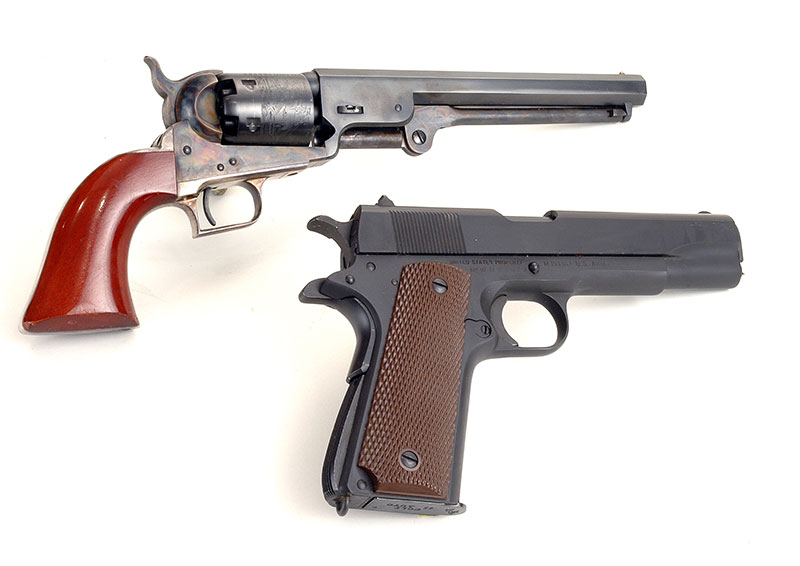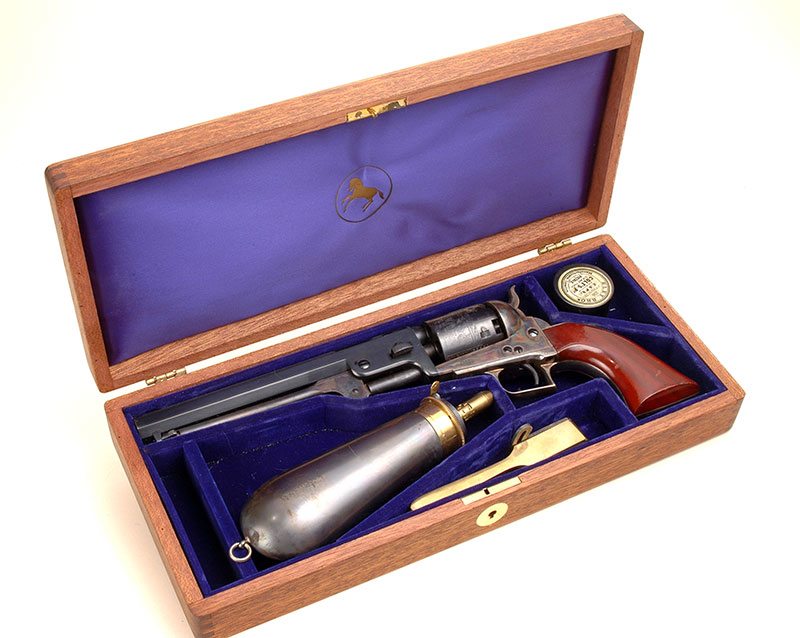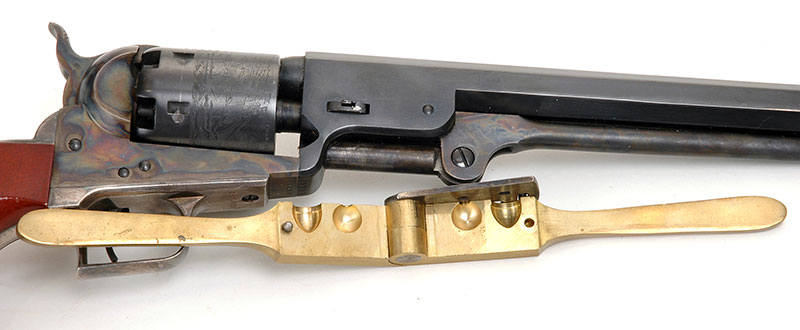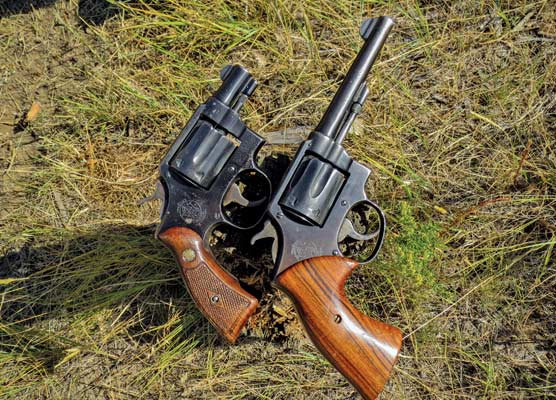Belt Pistol
Part 4 of 12 Part Genesis of the Colt Single Action
By the late 1840s America’s westward migration was in full swing, spurred along a great deal by the California gold rush of 1849. People by the thousands were heading west seeking fortunes or inexpensive land to settle upon. There was much danger involved in trekking westward at a rate of about four miles per hour. Indians both resented the intrusion of wagon trains and perceived them as easy prey: likewise with bandits for the latter reason. Bears, wolves, mountain lions and rattlesnakes lined every route west. There were just a whole heck of a lot of things from which a man might have to defend himself and family.
Samuel Colt saw this as another opportunity for revolver sales and so designed a new model to fit the situation. The Colt/Walker and Dragoons were weapons for professional fighting men going in harm’s way: issued in pairs, carried on saddles and meant for battles. The little Baby Dragoon and Model 1849 were small caliber, easily concealed personal defense weapons meant for stopping an assailant at belly-to-belly ranges.
Now came a revolver meant for stashing under a belt, in a sash, or most best of all stowed in a belt holster. It needed to be of reasonable weight, so .44 caliber was out, yet it needed to have more killing power than the tiny .31s. What Samuel Colt came up with in 1850 was a medium size frame mated to a 7½” octagonal barrel in what was then called .36 caliber. Again, because of the different manner in which caliber of a weapon was determined in those days, the projectile size of this new pistol was actually larger. Proper size balls were .375″ in diameter, which made them weigh 80 grains. Conical bullets could also be used.
Collectors today call this revolver the Model 1851 Navy, which is wrong on two counts. As said above it was actually introduced the year before. As a further misnomer neither was it ever adopted as “standard issue” by the United States Navy although that organization did buy some. Regardless, the name Navy became so identified with the revolver that .36 caliber was commonly called the “Navy caliber.”
The Colt Navy was a nickname bestowed on the new revolver because its roll-engraved cylinder scene portrayed ships of the Mexican Navy battling those from the Republic of Texas in 1843 when it was a nation instead of a state. This begs the question, “Why were Colt percussion revolver cylinders roll engraved in the first place? Evidently fakery in firearms was as common back then as it is today and Samuel Colt felt that by marking his revolvers they could be discerned from copycats.

With the advent of a Colt revolver of a size to be easily carried on a belt soon also came holsters in the Slim Jim style.
Also necessary would have been a belt pouch for caps, paper cartridges and most likely a small screwdriver.
If paper cartridges were not available, then loading could have been done with a powder flask.
No Lightweight
With a barrel length of 7½” and weight of 42 ounces the Colt ’51 certainly couldn’t be considered a lightweight in this day of scandium, titanium or aluminum frame revolvers. But that comparison is silly for it was the 66 ounces of a Colt Dragoon by which it was compared. Its cylinder had six chambers and like the Baby versions before it, trigger guard was brass but plated with silver. As with all Colt percussion revolvers the rear sight was a notch on the hammer spur and the front sight was a tiny brass stud akin to the beads seen today on shotgun barrels. Standard finish was color case hardened frame, hammer and rammer with barrel and cylinder blued. Early ’51 Navy sixguns had a rather small square back trigger guard. That was soon changed to a roomier round one. For some reason when Colt reintroduced the ’51 Navy in the 1970s they chose to use the small, square back trigger guard. It’s the only flaw in an otherwise very fine recreation of a most famous revolver.
Powder capacity of .36 Navy chambers is only 25 grains. That sounds puny compared to the big Walker and Dragoon .44s. Still 25 grains of Goex FFFg black powder propels an 80 grain pure lead round ball to just shy of 1,100 fps. That made ’51 Navy Colts powerful enough that they became the standard by which all other handguns of the era were judged. As late as the early 1870s, Wild Bill Hickok was still packing a pair of them as his standard weapons while city marshal of Hays City, Kansas.
During the American Civil War of 1861-1865 irregular troops in the Missouri and Kansas area favored Colt Navy revolvers as their weapons for raiding. It so happened that one of those guerilla fighters was a young fellow named Jesse James. In one skirmish someone planted a .36 caliber ball in his body. It was still there when he was killed in 1882.
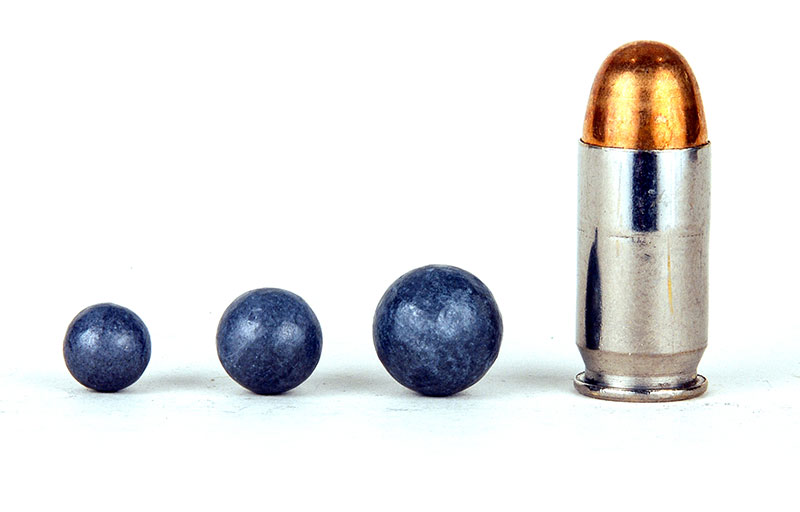
For size perspective a modern .45 ACP cartridge is shown at right with the three sizes of pure lead round balls for which Colt cap & ball revolvers were made. At left is a .325" (.31 caliber) 48-grain round ball. Center is a .375"
(.36 caliber) 80-grain round ball. At right is a .457" (.44 caliber) 148-grain round ball.
Gunfighters
As an adjunct to men “out west” commonly carrying revolvers on their persons, there soon arose the myth of the gunfighter. Supposedly opponents faced off on main streets at high noon and tried to outdraw one another. To the contrary it is nigh on impossible to find documentation of any gunfights where the antagonists faced off with their revolvers still holstered. Knowing they were about to enter a fracas, experienced fighting men had their handguns where they belonged — in their hands. While there is a dearth of documentation about fast draw gunfights, there is no lack of information about men in the 1850s, 1860s, and even early in the 1870s using Colt Navy revolvers on both sides of the law. Samuel Colt’s sales figures support that. Between 1850 and 1873 the company produced 215,000 .36 caliber ’51 Navy revolvers in America and another 42,000 were made in the short lived London factory.
The image of a tall, slender frontiersman packing a Colt Navy revolver cross draw in one of those attractive Slim Jim style holsters is an icon of the Old West.
Click Here To View List And Links To All Colt Series Articles

